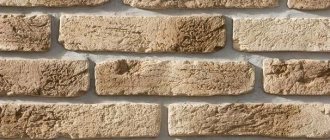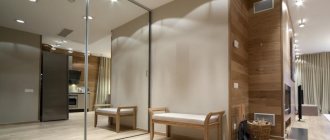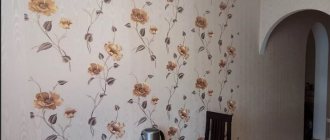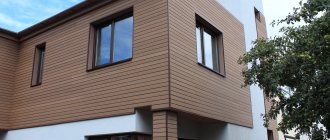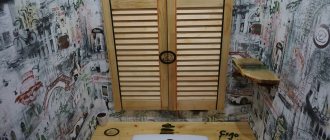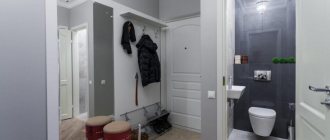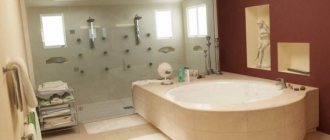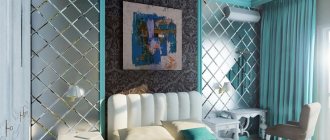The reason for the popularity of mosaics
Mosaic is a type of inlay that allows you to create amazingly beautiful images. Small multi-colored pieces of solid materials are arranged according to a pre-created sketch. There are two ways to perform a composition:
- direct set - mosaic elements are pressed into the ground;
- reverse set - the particles are placed face down on some kind of substrate, secured, the substrate is removed, and the seams are rubbed with adhesive.
To create mosaics, natural and artificial materials are used - glass, metal, enamel, pebbles, ceramics and others. When arranging the pieces, they lay out various patterns and drawings - thematic, folklore, geometric. People with creative abilities create real masterpieces of decorative art.
Laying mosaics on the wall is possible in any room with high humidity - in the bathroom, toilet.
Mosaic inserts look good in the kitchen interior Source pinimg.com
The pattern does not change color and does not deteriorate under the influence of steam or high temperature. Mosaic is easy to care for - the surface can be easily cleaned with a damp cloth and detergents. Mosaic finishing retains its original appearance for a long time, but when installed correctly.
Let's figure out how to put a mosaic on the wall so that it pleases the owners for many years.
Manually laying out patterns with small stones and glass takes a long time. To facilitate cladding, tesserae were created - square matrices with mosaic elements fixed on a grid. Mosaic tiles vary depending on the material:
- ceramic - have the same properties as tiles. It is characterized by high wear resistance, moisture resistance, strength, heat resistance, and ease of maintenance. May have a matte or glazed surface;
- glass - spectacular, but requiring careful selection of glue so that it does not shine through the material. They require complex care, as they are not resistant to aggressive environments and do not tolerate cleaning with abrasive agents;
Glass mosaic Source stroipark.com
- metal - made of aluminum or stainless steel. Mosaic looks unusual and is used to create exclusive interiors. Difficult to maintain and install;
- made of natural stone - expensive, allows you to create a luxurious design. Installation is carried out using ordinary glue or cement-sand mortar.
See also: Catalog of companies that specialize in finishing materials and related work
What style is it suitable for?
Mosaic is a universal decor and is suitable for many styles. It all depends on the color, texture and chosen pattern. The location of the mosaic element also plays an important role. Some trends are characterized by finishing only the walls, while for others this is unacceptable. Therefore, you should focus on the laws of the chosen style.
We will divide all proposed directions into two broad groups: historical and modern.
Trends of antiquity
Since mosaic was invented and gained popularity in ancient times, it is often used to recreate historical motifs. It is widely used in the Baroque and Rococo directions. At these times, this art was used mainly for flooring.
During the Gothic period, this type was widespread for finishing various surfaces. Along with stained glass, it was used within windows, on walls, and also on floors. This style is quite dark, characterized by sharp angles and straight lines, so choose dark matte tiles to recreate it.
The Victorian era is completely different and is reflected in the design accordingly. The style, which received the same name, is characterized by pomp and luxury in everything, from decoration to detail.
This direction is characterized by large images and large interior items, so large elements and corresponding patterns should also predominate in the design.
Mosaics were also widely known during the Renaissance. It was used everywhere here. The Renaissance period is considered one of the most beautiful, so colorful and positive motifs predominate in ornaments and designs. The direction is not devoid of brilliance and luxury, which is also reflected in the cladding.
Modern directions
Despite the fact that mosaic mainly emphasizes ancient trends, it is widely used in modern design. And with the advent of new materials and types, it has become quite popular nowadays.
- Perfect for the Mediterranean style trend. It has pronounced Greek motifs, so glossy and light tiles will only emphasize the advantages of the direction. In this case, mosaic tiles are used primarily for floor cladding. Artificial balconies and corresponding arrangement of bay windows are widespread here.
For these areas, this type of finishing is perfect. Speaking of colors: the Mediterranean style uses predominantly white, the whole spectrum of blue, light brown, and green.
- Provence is another style common in modern design. It is also called French country, so it is distinguished by tenderness and warmth. The hallmark of this trend is the beige color and rustic motifs in the design. In this case, the mosaic finish is used primarily in kitchen design. It is advisable to select models made from natural materials, light pastel colors and fine textures.
- stand apart . It has absorbed the trends of antiquity, and at the same time has undergone some changes in accordance with the present era. The use of the art described is also acceptable to her. But in this case it is necessary to emphasize rigor and conciseness. Classic has soft lines, but does not tolerate excesses. Choose simple patterns and soft colors to convey a classic feel.
Thus, if you decide to use mosaic in the interior of your apartment, first select a style, and then, acting in accordance with its laws, decide on the structure and type of tile.
In addition to full or partial finishing of walls or floors, you can use mosaic tiles to create interesting decorations that will become part of the design. Mosaic decoration of vases and boxes is still popular, and this technique is also used in creating original photo frames.
Subtleties of laying mosaics
Let's take a closer look at how to glue a mosaic on a wall. First of all, you need to prepare tools and materials:
- knife;
- grinder;
- glue;
- pencil;
- electric drill;
- bucket;
- grout;
- putty knife;
- mosaic tiles.
Laying includes the following steps:
- cleaning, priming, sanding, drying walls;
- surface marking - mark the layout of the tiles with a pencil;
- applying the adhesive composition to the wall and sheets with a spatula;
- mosaic installation - the tile is pressed to the surface with glue and pressed with a roller or spatula;
- removing the backing - run a wet sponge over the surface and remove the paper backing diagonally, pulling at the corner;
Removing the backing Source dizainvfoto.ru
- moisturizing and grouting;
- cleaning the tiles diagonally with a damp sponge;
- polishing with a dry cloth.
Surface preparation
An uneven surface can ruin the work done, so the first and main stage of laying mosaics is preparing the surface. The quality of surface leveling (screed, plaster or sheet leveling with plasterboard) is not lower than the level “for wallpapering”. Pay special attention to the horizontality and verticality of the surface (an error of no more than 1-2 mm is allowed at a distance of 3 m). The next step is to prime the surface. Pay attention to the color of the primer; if you are planning a glass mosaic, stick to light colors. Make a mark on paper and transfer it to the wall. If you have to cut the mosaic matrices, place them out of sight. Don't forget that surface preparation in wet areas includes a waterproofing layer.
Glue
Many people are interested in what to glue the mosaic onto so that it holds firmly. The adhesive composition must be carefully selected to match the properties of the wall surface, material, and operating conditions.
Special tile adhesive
The easiest way is to purchase a special adhesive for tiles at a building materials store, made on the basis of Portland cement with the addition of plasticizers. This is a ready-made composition that only requires dilution with water to the required thickness. The glue ensures reliable adhesion to any surface. This glue is not suitable for glass mosaics due to its light gray tint.
Tile adhesive Source purplemint.ru
Polymer glue
The acrylic-based mixture ensures reliable fixation of mosaics made of any materials on various surfaces. This is the best ready-made adhesive for rooms with humid air. Dyes are added to the composition, which makes it possible to use it to create interesting design solutions. Before use, stir and apply to the surface. The glue dries quickly, forming a glass-like mass.
Video description
About an example of laying mirror mosaics in the following video:
Interior details
The possibilities for decorating with mirror fragments are quite varied. Using mirror mosaics you can decorate the following objects and interior details:
- Mirror or picture frame, vase . Pieces of mirrors can be easily glued to any surface, turning a standard item into a memorable decor.
Mirror design Source design-homes.ru
- Fireplace . Glass is not afraid of high temperatures, so the original coating is suitable for facing a fireplace, not to mention a decorative fireplace portal.
Design of a fireplace portal Source susanjablon.com
- Furniture facades . You can decorate any object with glass decor: a table, a kitchen island, a wardrobe, a bar counter, a buffet or bedside tables.
Mirror squares with bevel on the cabinet facade Source oboiman.ru
- Nisha . If there is a niche in the wall, try lining it with a mosaic grid. As a result, you will get an original architectural detail, which will also look visually larger.
Niche design Source hzcdn.com
Nuances
Each type of mosaic tile requires compliance with certain gluing rules.
Let's look at how to glue mosaics on a grid.
The sheet is held with the front side facing you, and the back side is immersed in the adhesive Source colibrimosaic.ru
Gently press it against the wall with a roller or spatula so that the distance between the mosaic squares is the same. Remove any remaining glue and wait until it dries completely.
Recommendations
Knowing how to lay a mosaic correctly, listen to the advice of experienced craftsmen:
- do not press the sheets against the wall with your hands to avoid unevenness;
- to prevent the glue from drying out, the surface area should be no more than nine tiles;
- dilute the glue to a medium consistency, since a thick composition dries quickly, and a liquid one sticks;
- carry out installation at a temperature not exceeding +25 degrees;
- Apply mosaic adhesive on the mesh in a layer of no more than 3 mm, so that excess solution does not complicate the grouting.
Recommendations will help you avoid mistakes.
Mosaic masonry looks both solid and in combination with other materials. Source keram-market.ru
Advantages and disadvantages
To make a decision about using mosaics as decoration, it is important to understand the costs of arrangement. This interior solution is practical and durable, but its implementation requires considerable costs. The cost of mosaics is determined by the naturalness of the material, its quality and quantity, and special coating. If you do the mosaic installation yourself, it will help you save money, but it will take time. If you hire specialists, mosaic finishing will be expensive.
Related article: Features of installing MDF panels - advice from professionals
But there are also economical ways to decorate with mosaics. It is possible to tile and use mosaics for individual inserts. This way, you can make an accent and highlight some areas in the interior, adding a little personality.
Like any material, mosaic has its disadvantages. The material is quite expensive, especially from reputable manufacturers. Material made in an unknown place will also suit few people. Installation by a good specialist is also expensive. If we are talking about a small surface, then even without experience in repair work, you can do it yourself if you wish. A lot of experience will be required when finishing large surfaces; not every specialist will cope with the task efficiently. Of course, the cost of the work will be significantly higher than when laying conventional tiles.
Briefly about the main thing
Mosaic tiles allow you to quickly and inexpensively tile the surface of any room. The variety of types makes it possible to choose the best option for different wall surfaces.
The basic requirements for creating a beautiful and durable mosaic are knowledge of what material the tiles are suitable for the room, and what glue to use to glue the mosaic.
Mosaic allows you to implement any design idea at low cost. The cladding looks impressive, and its properties are not inferior to ceramic tiles.
After studying the instructions on how to lay mosaic tiles, you can decorate a bathroom, toilet or other room yourself. It is important to adhere to the rules and recommendations for laying mosaic tiles.
Ratings 0
